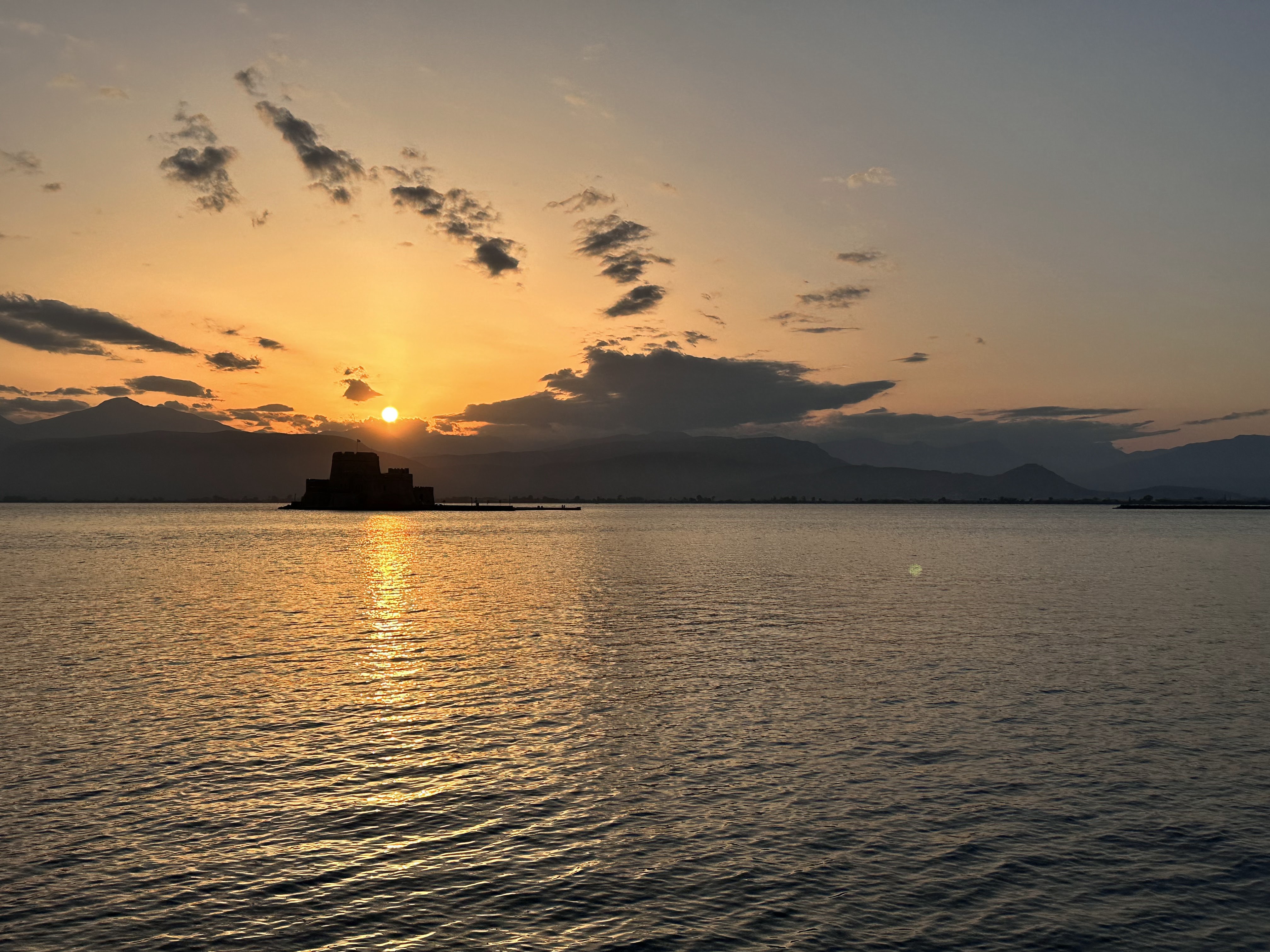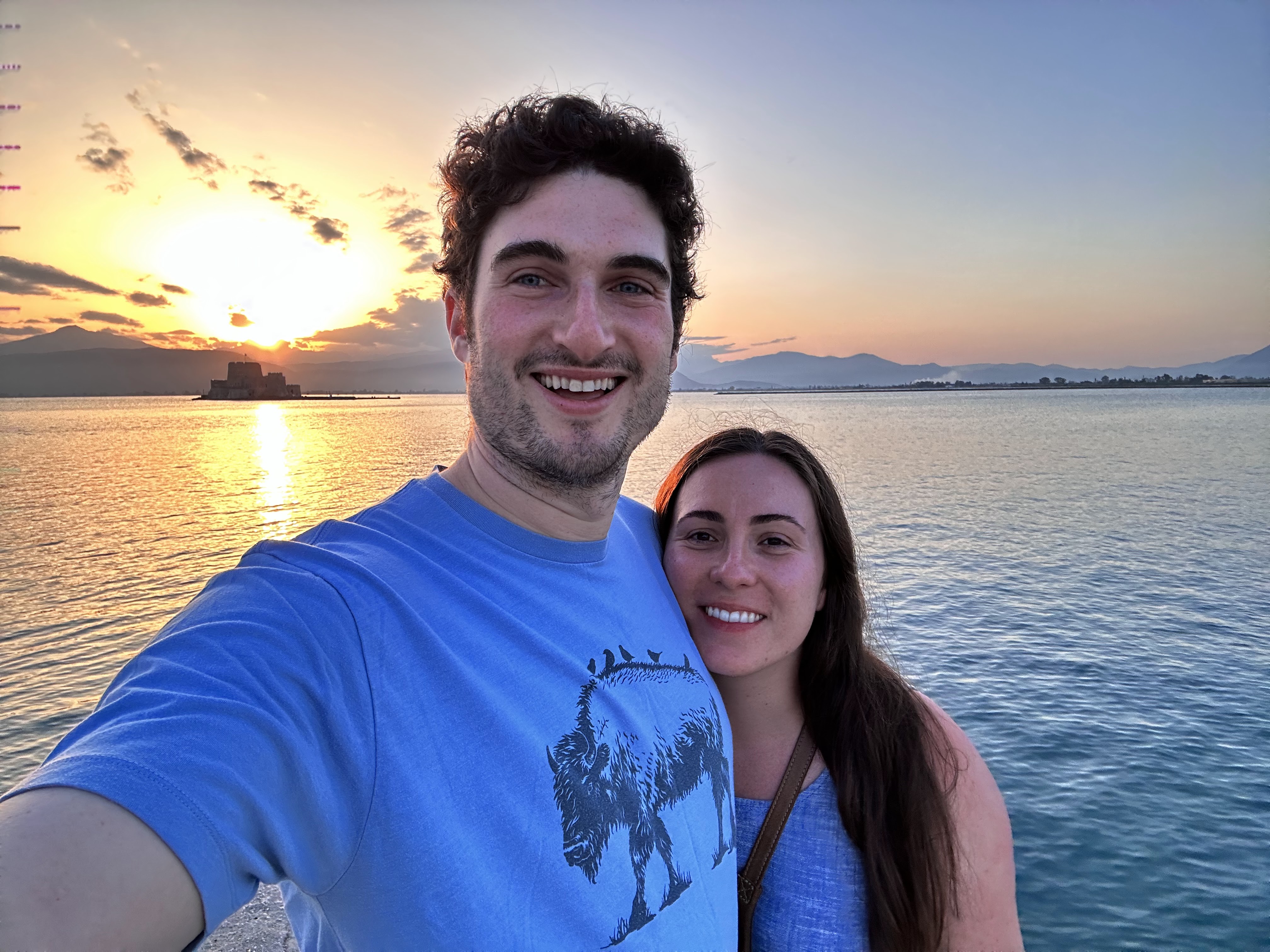First I’ll describe our hotel a bit. We stayed at a hotel called Pension Marianna. The parking for the hotel was on the street on a road halfway up a hill to an old Venetian fortress behind the hotel. To get into the hotel from the parking one had to walk down a narrow road, that we assumed was a pedestrian road when we first walked down, but later we saw small motorcycles. On the other side of the parking stands some derelict, abandoned buildings and past the building the hill falls off at a cliff where one can see down to the city beach. The road to the hotel passes under a small arch and then there’s a small gate that leads to the hotel.
The first building of the hotel complex is a lobby building. It is a small yellow, concrete building where the check in counter is. Guests eat breakfast on the patio of the building. The patio is also where the proprietors leave a bag of oranges from their farm out.
There are some rooms in this first building. The rest of the rooms are split among stone building that surround three courtyards. The courtyards are progressively further down the hill. Our room was in the final courtyard, so we had to walk down three flights of stairs to get to our room. In each courtyard were little tables where one could sit and admire the view of Padamili castle.
While we ate breakfast, some old people were contemplating driving routes on a big paper map. They were driving over to the Mani. I gave them some advice on roads; I told them about the sort of closed road in the mountains between Mystras and Kalamata. Lizy piped in and told them to go to the Diros Caves. They didn’t question our cave credentials like the old guy in Kardamili, but just took the advice.
A middle aged woman sitting beside us with her husband overheard, and said, “See someone else is telling us to go to the caves.” He agreed, but seemed uncertain. He had planned every moment of their next couple of days and felt uncomfortable making drastic changes. We talked a little with this couple and they started describing some of the places thy had already been. They had just climbed the stairs to Padimili castle a third time before breakfast.
“So has Nafplion changed much since you were last here,”
“Oh, it’s our first time.”
“I thought you said you’ve been up the stairs three times.”
“Ya three times this trip. We’ve been here two days. We’re leaving today and we had to go up one last time. It’s 1000 steps. Twenty minutes up then ten minutes down.”
These people were really into walking up stairs it seemed. The couple they were with hadn’t gone up the stairs a single time. Since you could drive up, the first time their friends had driven up to the top and they had driven down together.
I’m going to to interject this event to mention something that happened a couple of days later. At the hotel we stayed in Chania, Crete, the bartender told us a story about Padamili castle. When she went to Nafplion with her husband and children she refrained from telling them about the road for cars. She told them the only way to get to the castle was by walking up the stairs. When they finally got to the top her son saw the road. He was so angry he told his mother he’d never talk to her again. I thought this was funny.
Anyways back to Nafplion, this couple beside us started talking about some of the places they had been before Nafplion. They lightly complained about all the reference to poetry and literature the couple they were traveling with kept making. What can you expect traveling with a professor?
“Wait where did you say you were from again,” asked Lizy.
“Iowa.”
“And is the professor from Butler?”
“Yes, how did you know that?”
“Is her name Helene —?”
“Yes” the woman seemed shocked, “do you know her?”
“Ya, she edited a book I contributed a chapter too. I saw she was in Greece on facebook, but I never imagined I’d bump into her.”
What a coincidence. What were the chances? On our way out of the hotel we stopped by the breakfast nook again, and Helene was there with her husband. Lizy was happy to see her.
Our first stop of the day was to the archeological site of Epidavros. Epidavros was a Greek city founded at least before the classical era (400s BC) and continued to be a major city through at least the early Roman empire. Epidavros was best known as a centre for healing. During classical times the patron god of the city was Asclepius, the god of healing, who gave the city the power to heal (sort of like how Athena gave Athens protection and olives) After the Roman Empire converted to Christianity, probably the god was converted to a Christian saint as was commonly done, so they could continue to play the role as a healing centre, although this is just a guess and I don’t have a source for this Christian continuation of the cult. Greeks and later Romans would travel from far and wide to come to Epidavros to be healed of their various ailments.
The main archeological site is located where the classical Greek city had their temples and theatre, while the residential area of ancient city was closer to the coast, still covered by a modern city. The theatre was in very good shape for being at least 2000 years old. Lizy and I took turns running up the steps of the stands to check the acoustics. Voices from the stage were projected by the geometry of the theatre into the stands with almost no loss in volume or clarity. And voices from the stands could not be heard at all from the stage. The Greeks had done a great job. When Lizy was in the stands and I was standing on the stage I teased her that finally I could talk to her without having to listen to her reply. The theatre had recently begun to host plays again during the festival of Athens during the months of June and July. If I ever come back to Greece, I’ll definitely try and plan around going to a play there.
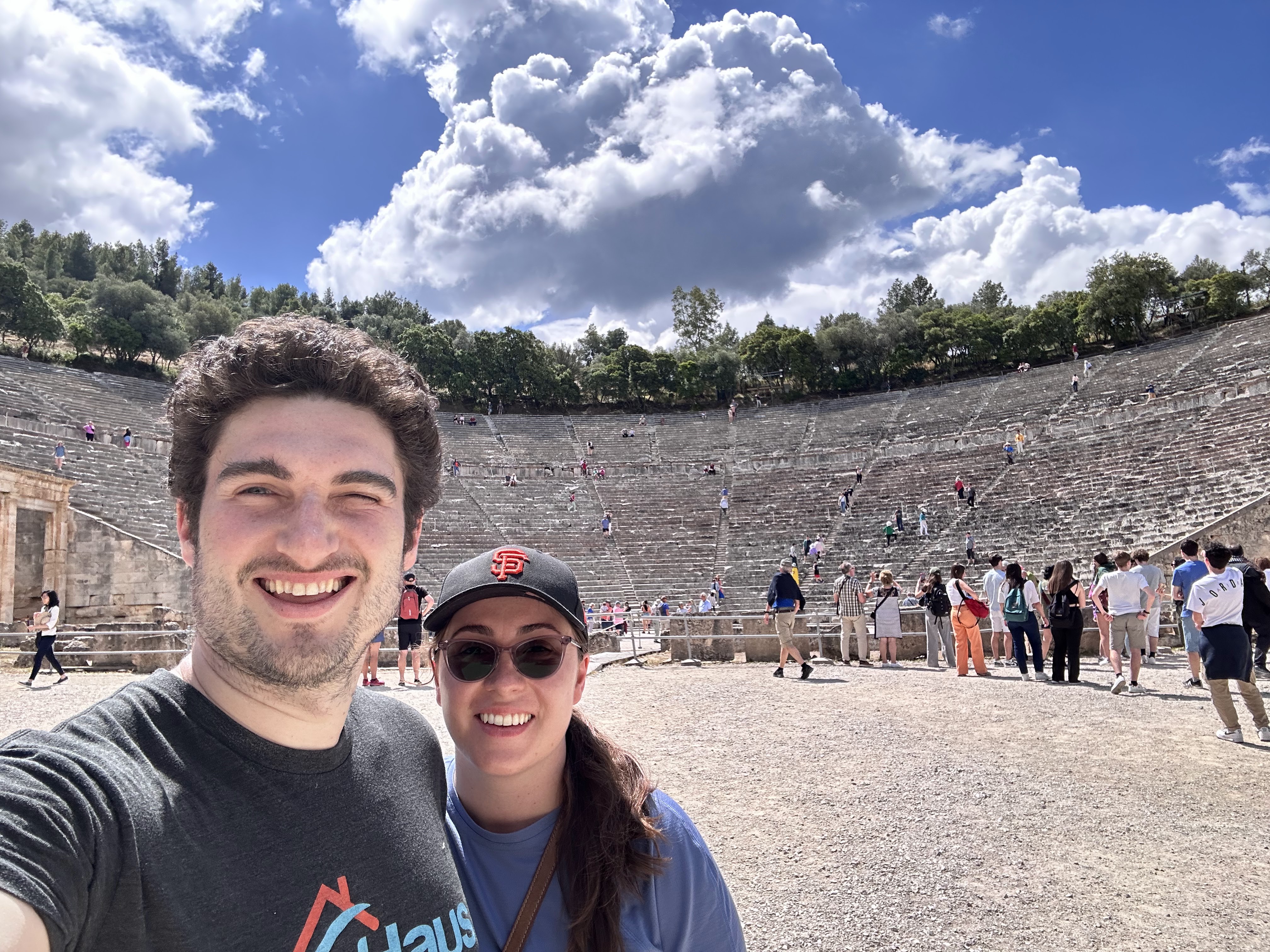
We walked around the rest of the grounds to see the temples. The rest of the building were in much worse shape. Everything that could be toppled over, was toppled over. Various building were being restored by the government to give people a better idea of what the site looked like in antiquity.
We saw the hotel where visitors would stay while being healed and the infirmary where the ancient priests would heal the visitors. I imagine the healing was rudimentary, as the ancient Greeks were very scared of cutting open humans after they had died, so they must’ve had fairly incomplete knowledge of the inner workings of the body. They had a small museum where we saw some of the medical devices of antiquity found at the site including tweezers and forceps.
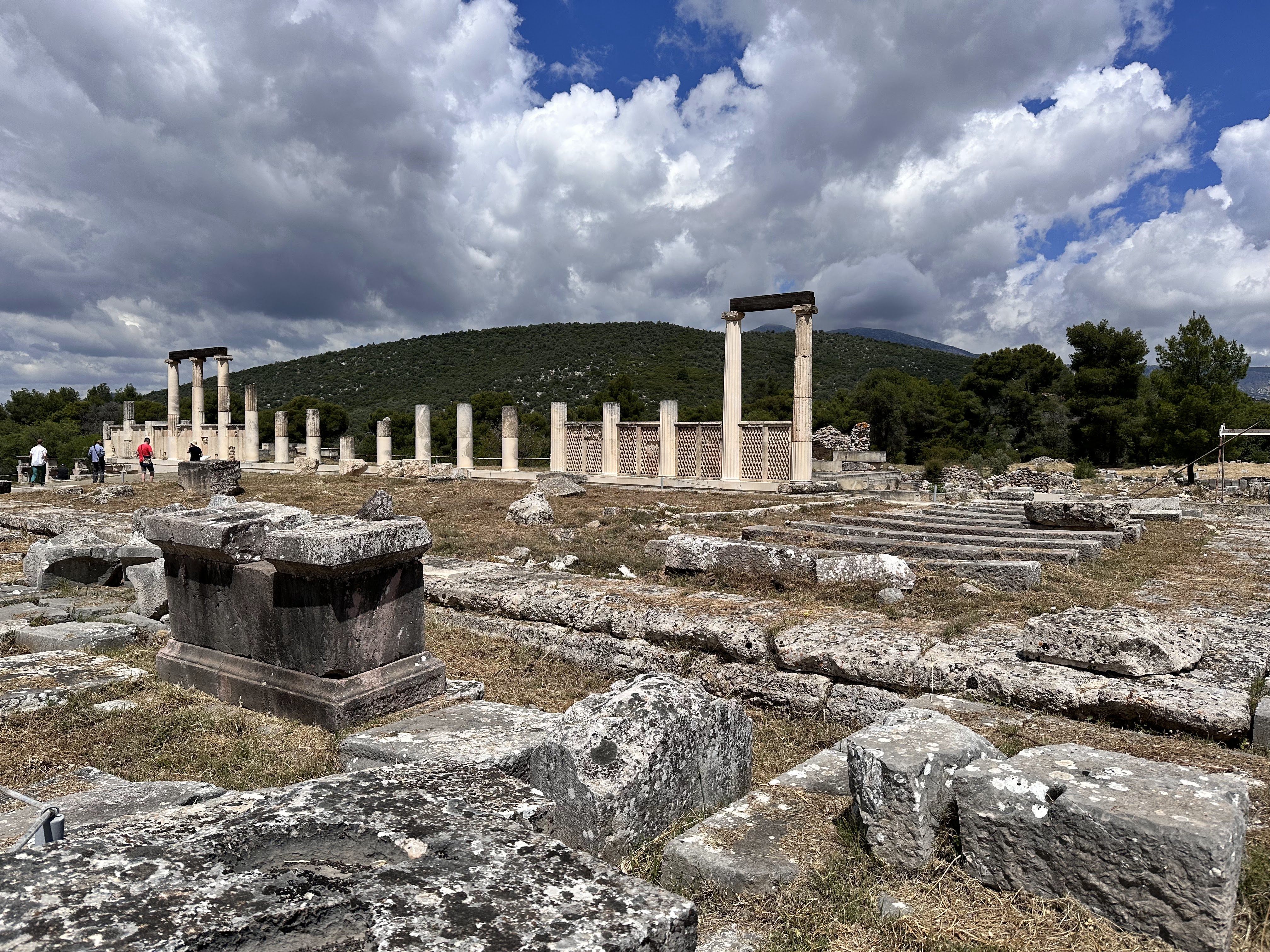
Unrelated to medicine, there was also a small stadium built into a natural concave indentation in the ground. The stands were carved into the natural concave walls. According to the sign at the site, school children had recently begun to use the stadium for some of their track and field events, to create a continuity between antiquity and present day.
After we finished touring the ruins, we headed to a beach on the outskirts of the modern city of Epidavros, built right on top of the ancient city and little ways away from the archeological site. I had read the night before in Crete Swim that there were some ancient ruins that had been swallowed by the rising sea and that once could swim over. I was a little uncertain if the gps coordinates in the book were accurate though and when our car’s gps took us down a small alley I became nervous. But sure enough we found the beach we were looking for. A handful of cars were parked, including two big RV campers with a child running back and forth between the campers.
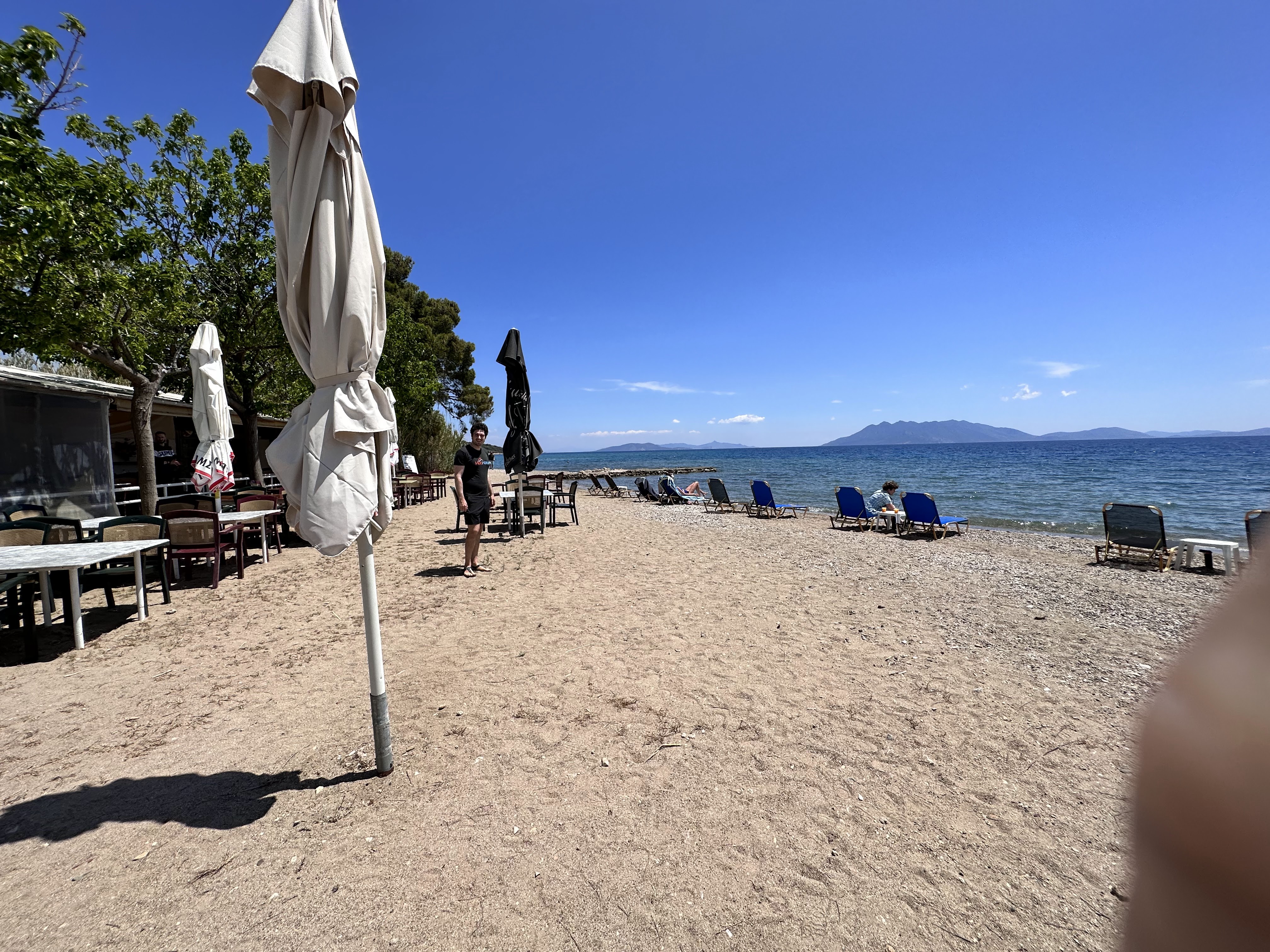
There was a tavern on the beach with tables and beach chairs. Walking further down the beach past the tavern, was the sign we were looking for. A small metal, rusted sign with an arrow pointed towards the sea and the words “Sunken City” painted on its face. On the beach near the sign was a small tour group. You could hire this company to take you on a day trip here and they’d give you snorkels and kayaks. Not sure why you’d want a kayak because the ruins were around 20 m away from the beach.

We put our towels down and headed out into the water. I tried to yell to Lizy, who had raced ahead, that she had to look down and be wary of the sea urchins. She didn’t hear me and didn’t notice the urchins, but somehow managed to avoid all of them. As soon as the water got waist deep I started swimming to avoid stepping on one.
The sea was calm. We swam around the ruins. There were huge broken spherical chambers made of stones and the foundations of big rooms. Sea urchins were stuck to all the surfaces of the ruins as if protecting the site. There were large schools of black and white fish hanging out in one of the rooms as if they lived there now. The Roman villa had in all ways been taken over by the sea.
We explored the ruins for 30 minutes, before heading back to the beach. The tourist group had left. There was an Italian couple heading out to the sunken city, but other than them there was no one left on that part of the beach. We walked back down to the taverna on the beach and sat down for lunch. The waiter was having trouble describing for me the types of fresh fish they had to grill in English, so he went back to the kitchen and brought the two types they had out to our table raw, for me to inspect. They looked like types of white fish, but I’m not sure what their names were.
After lunch we sat on the taverna’s beach chairs for a while. I read my book for the first time since the plane ride to Greece. A few more people trickled into the beach as we sat there. There was an old Greek couple that started to play backgammon. There was a Greek family with a bunch of small kids running around. The kids went into the sea and threw around a ball. After a while one of the kids got bored throwing around the ball, and picked up a sea urchin by one of it’s spikes and tried to throw it at her brother.
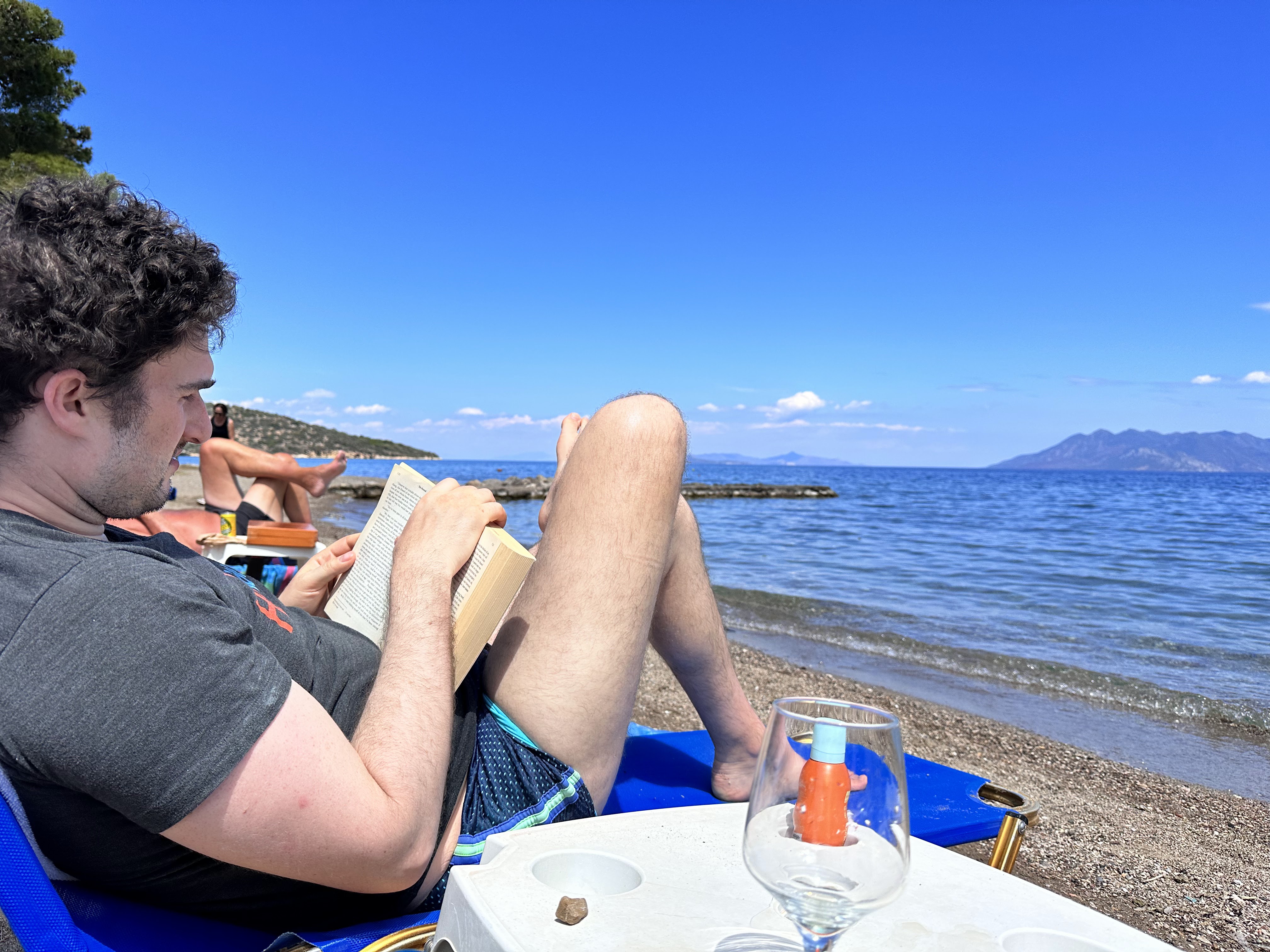
“I thought you said you couldn’t touch them.” Lizy said to me.
“I guess you can grab them by the needle, but only if you’re a child.”
Back in Nafplion we had dinner overlooking the harbour, then went to sleep early.
